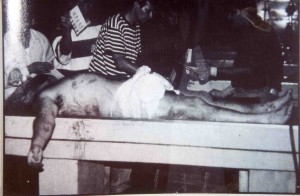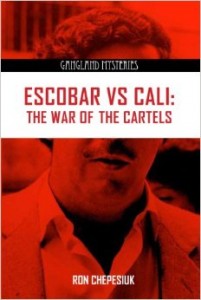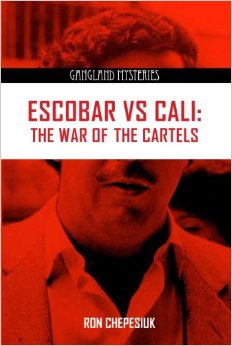 In July 1993, Drug lord Pablo Escobar sneaked away into the night, even though 500 soldiers surrounded the prison. He first fled to a ranch, La Romelia, and waited in a hiding place until the initial search patrols left the area and the commotion surrounding his escape subsided. Then Escobar moved to Llanogrande, close to Rionegro, and renewed his life as a fugitive. Once again, the Patron had embarrassed the state. Gaviria knew he had to recapture the drug lord or forget about having an honorable place in Colombian history. This time Escobar would have a much more difficult time eluding his enemies, for Search Block was just one foe among exit the king many he had to worry about.
In July 1993, Drug lord Pablo Escobar sneaked away into the night, even though 500 soldiers surrounded the prison. He first fled to a ranch, La Romelia, and waited in a hiding place until the initial search patrols left the area and the commotion surrounding his escape subsided. Then Escobar moved to Llanogrande, close to Rionegro, and renewed his life as a fugitive. Once again, the Patron had embarrassed the state. Gaviria knew he had to recapture the drug lord or forget about having an honorable place in Colombian history. This time Escobar would have a much more difficult time eluding his enemies, for Search Block was just one foe among exit the king many he had to worry about.
The families of the Moncadas and Galeanos had vowed revenge and were scheming to exact it. The associates who still remained alive were tired of his bullying ways and of having to put up money to finance his wars with the state.
They did not want to be next to be lured to a meeting with El Patron, only to be summarily tortured and killed. Even his powerful paramilitary allies began to wonder if they could trust Pablo. Paramilitary leader Fidel Castano, who was good friends with the Galeanos and the Moncadas as well an associate of Escobar, was on the “guest” list at the Cathedral the night they were killed. So Escobar had few allies upon whom he could count for strong support.
And he also had to worry about the godfathers in Cali, who knew they would never have a good night’s sleep until they removed their bitter enemy from the scene. On 30 January 1993, a bomb exploded in downtown Bogota, killing twenty people. It was narco war as usual in Colombia. The country’s public enemy number one had sent a message to the nation: Brace yourself I’m back in the business of attacking the state and unleashing mayhem. But then there was a surprise. The following day, two bombs – one containing an estimated 100 kilos of dynamite and the other containing eighty kilos – exploded in Medellin in front of apartment buildings where Escobar’s wife, two children, his sister and his mother-in-law were staying. It was another close call for the Boss.
Meanwhile, five men showed up at the weekend country retreat of Escobar’s mother, located about forty-five miles from Medellin, ordered the lone caretaker out and blew up the place. In a communiqué released to the press on February 2, a new group calling itself “Persecuted by Pablo Escobar” (Los Pepes) claimed responsibility for the attacks. The communiqué declared that Pepes were working toward “the total elimination of Pablo Escobar, his followers, and his assets to give him a taste of his medicine, which he unfairly dishes out to so many.” Escobar struck back. Mid-morning on February 15 two powerful bombs exploded five minutes and twelve blocks apart in downtown Bogota, killing four people and injuring more than 100 others.
They were the fifth and sixth car bombs since Escobar’s mid-January declaration of war against the state. But a few hours later, in Medellin, unidentified men traveling in a blue Toyota camper torched an Escobar-owned luxury house in the exclusive El Poblado section.
It was the Pepes again, showing they meant what they had vowed – tit for tat each time Escobar committed a terrorist act. Two days later, gunmen killed Carlos Mario Ossa, a high ranking Escobar financier who was helping to pay for Escobar’s terrorist campaign. The same day, Carlos Alzate, a coordinator of Escobar’s sicario groups, surrendered. Ossa was a key person in passing instructions from Escobar to Alzate, and with Ossa’s death, Alzate had no way of communicating with the Patron. Better to come out of the cold than to end up in a morgue. The Pepes were seriously starting to disrupt Escobar’s organization.
But on March 5, the Pepes declared a ceasefire, giving no reason for their action, although the press speculated that it was done to give Escobar time to surrender. That did not happen, and exactly one month later the Pepes issued another communiqué, announcing their “commitment to the total annihilation of Escobar,” even if “he was captured and put in jail.”
In other words, the Pepes were saying, “We will get you, Pablo, no matter what you do.” The Pepes continued to attack Escobar’s infrastructure, causing anyone associated with him to fear for their lives. Assassins gunned down two lawyers employed by Escobar’s brother Roberto and associate Carlos Alzate. The same day, the Pepes killed Escobar’s most important attorney, Guido Parra, and Parra’s eighteen-year-old son in retaliation for Escobar’s north Bogota car bomb that killed eleven and injured over 200 people.
It became obvious that the Pepes were actually trying not only to kill Escobar but also to humiliate him. That was evident when they stole “Terremoto,” a stallion owned by exit the king Escobar’s brother Roberto and valued at more than $1 million, and then returned it in a slightly altered condition – gelded. Terremoto was tied to a sign that read: “We return the horse to the terrible Escobar and his brother.” The Pepes also murdered Roberto’s horse trainer.
Oscar Cardona Zuleta. In a cable, the U.S. embassy noted, “The loss of Terremoto as a sire is seen locally as a grave insult to the Escobars.” The carnage caused by the Pepes was unremitting. By mid-November, they had assassinated fifty of Escobar’s people, including his brother-in-law, and destroyed some twenty properties belonging to his relatives and associates. The vigilantes could not catch the big fish, but they were slowly poisoning the sea in which it swam. They were embarrassing the Colombian government as well. Why was not the Gaviria administration getting control of the situation, Colombians wondered?
Are the Pepes and government working together? Gustavo De Greiff, the country’s prosecuting attorney general, said that his office seriously tried to investigate the Pepes, but it was never able to get any good information or leads on the people behind it. When the Gaviria administration issued a $1.39-million dollar reward for the capture of the Pepes’ leaders, the group once again announced its intention to disband. Escobar, however, was not impressed.
The drug lord suspected the government and the Pepes were in cahoots against him, and he didn’t believe the administration had any real intentions of identifying the people behind Los Pepes In a letter to the government dated August 29, Escobar charged that “the government offers rewards for the leaders of the Medellin Cartel and for the leaders of the guerrillas, but it doesn’t offer rewards for the leaders of the paramilitaries, nor for those of the Cali Cartel, authors of various car bombs in the city of Medellin.” He identified the individuals whom he believed to be behind the Pepes the four leaders of the Cali cartel (the Rodriguez brothers, Santacruz Londono, and Herrera) and paramilitary leader Carlos Castano.
Were the Pepes and the Colombian government working together? During the period that the Pepes launched their campaign against Escobar, U.S. and Colombian officials publicly denied the Cali cartel had supplied them with information that was helping in the hunt for Escobar.
Today, officials readily acknowledge that the men from Cali played the key role in taking down Escobar. “As soon as Escobar killed the Galeanos and Moncadas, their people saw themselves as vulnerable and they ran to the Cali cartel and said, ‘We want to change sides,’” said Joe Toft, chief of the DEA’s Bogota office from 1988 to 1994. “The Cali people said, ‘Okay, if you want to change sides, you need to pay us.’ A lot of money changed hands.”
The Colombian government was in a death struggle with Escobar and it did not care where information came from, so long as it was credible. “The Colombian government wasn’t going to get information about Escobar from the Vatican,” explained Robert Nieves, the DEA’s chief of international operations from 1989 to 1995. “Sometimes, having to deal with scumbags is the nature of the beast. Sometimes, you have to get into the sewer because that’s where you’ll get the best information.”
 This is an excerpt from Ron Chepesiuk’s new book, Escobar versus Cali: The War of the Cartels
This is an excerpt from Ron Chepesiuk’s new book, Escobar versus Cali: The War of the Cartels
You can order it from www.amazon.com or www.strategicmediabooks.com
Ron Chepesiuk is award winning freelance investigative journalist, documentary producer and Executive Producer and co-host of the Crime Beat radio show (www.artistfirst.com/crimebeat.htm). He is a Fulbright scholar and a consultant to the History Channel’s Gangland documentary series. His true crime books include Black Caesar, Black Gangsters of Chicago, Gangsters of Harlem Gangsters of Miami” and Sergeant Smack: The Lives and Times of Ike Atkinson. Kingpin, and his Band of Brothers.



